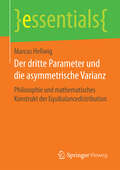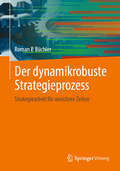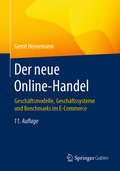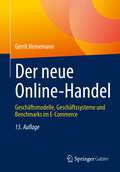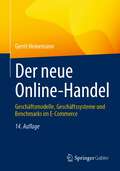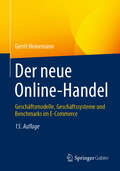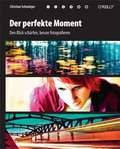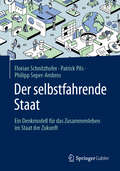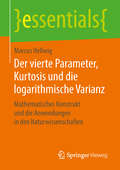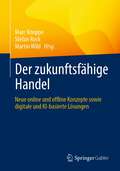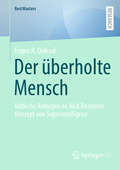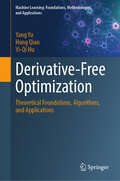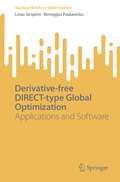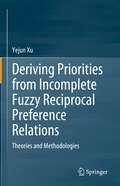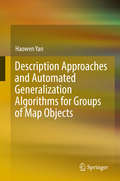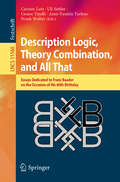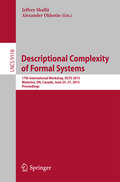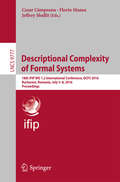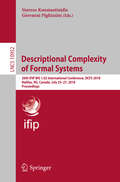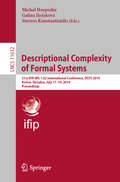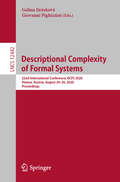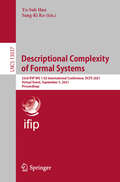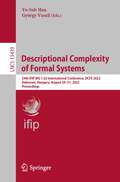- Table View
- List View
Der dritte Parameter und die asymmetrische Varianz: Philosophie und mathematisches Konstrukt der Equibalancedistribution (essentials)
by Marcus HellwigMarcus Hellwig zeigt, dass die Equibalancedistribution, deren Dichte nachweislich bei 1 liegt, #65533;ber einen dritten Parameter verf#65533;gt, der links- oder rechtsschiefe Varianzen ber#65533;cksichtigt. Die neue Funktion ist Werkzeug f#65533;r zum Beispiel das Taguchi-Prozessmanagement oder das Qualit#65533;tsmanagement im Allgemeinen und f#65533;r viele weitere Anwendungen. Bisher wurden links- oder rechtsschiefe H#65533;ufigkeitsverteilungen mit normalverteilten Dichtefunktionen untersucht. Bei Unstimmigkeiten hielt unter anderem ein positiver Kolmogorov-Smirnov Test als Nachweis her, dass eine H#65533;ufigkeitsverteilung normalverteilt sei. Die bislang zur Beschreibung wissenschaftlicher Untersuchungen herangezogene symmetrische Normalverteilung ist darin weiterhin als vereinfachter Sonderfall enthalten. Dieses essential ist die Fortsetzung des essentials ,,Equibalancedistribution - asymmetrische Dichteverteilung".
Der dynamikrobuste Strategieprozess: Strategiearbeit für unsichere Zeiten
by Roman P. BüchlerStrategiearbeit braucht ein Upgrade. Strategie muss omnipräsent werden. Kürzere Zyklen lassen die Strategie schneller an das reale Marktgeschehen anpassen. Zudem lässt sie sich im Tagesgeschäft deutlich besser verankern. Mit dem dynamikrobusten Strategieprozess liefert Roman P. Büchler einen zukunftsfähigen Ansatz für unsichere Zeiten.
Der neue Online-Handel: Geschäftsmodelle, Geschäftssysteme und Benchmarks im E-Commerce
by Gerrit HeinemannDieses Buch präsentiert Entwicklungen und Zukunftstrends im E-Commerce, der durch die neuen digitalen Kommunikations- und Konsummuster der Kunden geprägt ist. Gerrit Heinemann beleuchtet E-Commerce-Geschäftsmodelle, Kanalexzellenz sowie Erfolgsfaktoren wie digitale Zeitvorteile und Kundenzentrierung. Er analysiert die digitalen Herausforderungen und zeigt die Konsequenzen und die mit dem Online-Handel verbundenen Chancen auf. Anerkannte Best Practices veranschaulichen, wie erfolgreicher Digital Commerce funktioniert und was die „Lessons Learned“ der letzten Jahre sind.Die 11. Auflage beschreibt, was Online-Händler tun können, um sich neu zu erfinden und gegen Amazon bestehen zu können, und was Gründer bedenken sollten, um im Online-Handel mit innovativen Geschäftsmodellen erfolgsträchtig zu starten. Alle Kapitel wurden überarbeitet und um aktuelle Themen wie Performance-Marketing, Audience Targeting, Digital Branding und Shop-Design sowie um neue Erkenntnisse der ExO-Organisation und des Frictionless Business erweitert. Insbesondere berücksichtigt wurden zahlreiche neue rechtliche Anforderungen, wie u.a. die Zwei-Faktor-Authentifizierung, die Geoblocking-Verordnung sowie natürlich DSGVO und Uploadfilter.Der InhaltMeta-Targeting und Geschäftsideen im Online-HandelGeschäftsmodell des Online-HandelsFormen des Online-HandelsGeschäftssysteme und Benchmarks im E-CommerceBest Practices und Risiken im Online-HandelDer AutorProf. Dr. Gerrit Heinemann ist Professor für Betriebswirtschaftslehre, Management und Handel sowie Leiter des eWeb Research Center an der Hochschule Niederrhein.
Der neue Online-Handel: Geschäftsmodelle, Geschäftssysteme und Benchmarks im E-Commerce
by Gerrit HeinemannDieses Buch präsentiert Entwicklungen und Zukunftstrends im E-Commerce, der durch die neuen digitalen Kommunikations- und Konsummuster der Kunden geprägt ist. Gerrit Heinemann beleuchtet E-Commerce-Geschäftsmodelle, Kanalexzellenz sowie Erfolgsfaktoren wie digitale Zeitvorteile und Kundenzentrierung. Er analysiert die digitalen Herausforderungen und zeigt die Konsequenzen und die mit dem Online-Handel verbundenen Chancen auf. Anerkannte Best Practices veranschaulichen, wie erfolgreicher Digital Commerce funktioniert und was die „Lessons Learned“ der letzten Jahre sind.Die 13. Auflage liefert einen schnellen Überblick über die aktuellen Neuerungen und Trends im Online-Handel, die sich nicht nur auf Marktplätze, sondern auch auf Lieferanten und D2C-Online-Händler auswirken. In diesem Zug wurden auch die rechtlichen Anforderungen wieder auf den neuesten Stand gebracht. Zudem wurden alle Kapitel überarbeitet.Der InhaltMeta-Targeting und Geschäftsideen im Online-HandelGeschäftsmodell des Online-HandelsFormen des Online-HandelsGeschäftssysteme und Benchmarks im E-CommerceBest Practices und Risiken im Online-Handel
Der neue Online-Handel: Geschäftsmodelle, Geschäftssysteme und Benchmarks im E-Commerce
by Gerrit HeinemannDieses Buch präsentiert Entwicklungen und Zukunftstrends im E-Commerce, der durch die neuen digitalen Kommunikations- und Konsummuster der Kunden geprägt ist. Gerrit Heinemann beleuchtet E-Commerce-Geschäftsmodelle, Kanalexzellenz sowie Erfolgsfaktoren wie digitale Zeitvorteile und Kundenzentrierung. Er analysiert die digitalen Herausforderungen und zeigt die Konsequenzen und die mit dem Online-Handel verbundenen Chancen auf. Anerkannte Best Practices veranschaulichen, wie erfolgreicher Digital Commerce funktioniert und was die „Lessons Learned“ der letzten Jahre sind.Die 14. Auflage geht der Frage nach: Ist der Online-Boom endgültig Geschichte oder wird er wieder durchstarten nach der Krisenzeit? Wie geht es langfristig weiter? Darüber hinaus werden neue Trends (z.B. ChatGPT, neue Webdesigntrends), Änderungen im Internetrecht sowie das Thema „Insolvenzfall Online-Handel“ aufgegriffen. Zudem wurden alle Kapitel überarbeitet und neue Best-Practice-Beispiele integriert.Der Inhalt• Meta-Targeting und Geschäftsideen im Online-Handel• Geschäftsmodell des Online-Handels• Formen des Online-Handels• Geschäftssysteme und Benchmarks im E-Commerce• Best Practices und Risiken im Online-Handel
Der neue Online-Handel: Geschäftsmodelle, Geschäftssysteme und Benchmarks im E-Commerce
by Gerrit HeinemannDieses Buch präsentiert Entwicklungen und Zukunftstrends im E-Commerce, der durch die neuen digitalen Kommunikations- und Konsummuster der Kunden geprägt ist. Gerrit Heinemann beleuchtet E-Commerce-Geschäftsmodelle, Kanalexzellenz sowie Erfolgsfaktoren wie digitale Zeitvorteile und Kundenzentrierung. Er analysiert die digitalen Herausforderungen und zeigt die Konsequenzen und die mit dem Online-Handel verbundenen Chancen auf. Anerkannte Best Practices veranschaulichen, wie erfolgreicher Digital Commerce funktioniert und was die „Lessons Learned“ der letzten Jahre sind. Die 15. Auflage diskutiert umfassend die Frage: Wird der Online-Boom wieder durchstarten nach dem Dauerkrisenmodus und wie sieht es langfristig aus? Darüber hinaus werden neue Entwicklungen, wie z.B. asiatische Plattformen und der Siegeszug der fokussierten Shopping Apps (Multi-Purpose-Apps versus Multi-Experience-Apps), Änderungen im Internetrecht sowie die Themen „Online-Effizienz“ sowie „Generative KI“ aufgegriffen. Zudem wurden alle Kapitel überarbeitet und neue Best-Practice-Beispiele integriert. Der Inhalt • Meta-Targeting und Geschäftsideen im Online-Handel • Geschäftsmodell des Online-Handels • Formen des Online-Handels • Geschäftssysteme und Benchmarks im E-Commerce • Best Practices und Risiken im Online-Handel
Der perfekte Moment: Den Blick schärfen, besser fotografieren
by Christian SchnalzgerDen Blick schärfen, besser fotografieren
Der selbstfahrende Staat: Ein Denkmodell für das Zusammenleben im Staat der Zukunft
by Florian Schnitzhofer Patrick Pils Philipp Seper-AmbrosEin Staat, in dem die klassische Bürokratie der Vergangenheit angehört und die Verwaltung nahtlos, effizient und serviceorientiert funktioniert: Diese Vorstellung verbirgt sich hinter dem Denkmodell eines selbstfahrenden Staates, das in diesem Buch entwickelt wird. Mit jahrzehntelangen Erfahrungen in der Beratung des öffentlichen Sektors in Deutschland und Österreich entwerfen die Autoren ein visionäres Konzept für eine Verwaltung, die durch Künstliche Intelligenz und automatisierte Prozesse gesteuert wird. Sie führen dabei durch alle Entwicklungsstufen des selbstfahrenden Staates – von den Grundlagen klassischer Bürokratie bis hin zur autonomen Entscheidungsfindung. Das Buch richtet sich an Führungskräfte und Mitarbeitende aus Politik und Verwaltung sowie an alle, die sich für die Zukunft der öffentlichen Verwaltung und ein fortschrittliches Zusammenleben interessieren. Sie erfahren, wie digitale Gesetzeszwillinge, effizientere Verwaltungsprozesse und verbesserte Services die Lebensqualität der Bürgerinnen und Bürger sowie die Geschäftsabläufe von Unternehmen optimieren. Die vielen praxisnahen Beispiele zeigen, wie diese Vision Realität werden kann.
Der vierte Parameter, Kurtosis und die logarithmische Varianz: Mathematisches Konstrukt Und Die Anwendungen In Den Naturwissenschaften (Essentials)
by Marcus HellwigMarcus Hellwig zeigt auf, wie Asymmetrie die Natur und deren Gesetze beherrscht. Er diskutiert, dass nichts, das zu beobachten und zu messen ist, mit vollständig symmetrischen Eigenschaften erscheint. Die logarithmische Equibalancedistribution Eqbl als Variante der Eqb soll dort Abhilfe schaffen, wo die allgegenwärtige Gauß`sche Normalverteilung vom Grundsatz her nicht anwendbar ist. Im Gegensatz zur Log-Normalverteilung haben aber alle Parameterwerte Bestand und erhalten zusätzlich Parameter für Schiefe und Kurtosis. Der Autor belegt die Ausführungen anhand praktischer Beispiele für Anwender.Der Autor Dipl.-Ing. Marcus Hellwig war Projektleiter bei einem deutschen, international agierenden Ingenieurbüro und ist Autor einiger Bücher.
Der zukunftsfähige Handel: Neue online und offline Konzepte sowie digitale und KI-basierte Lösungen
by Marc Knoppe Martin Wild Stefan RockDieses Buch gibt einen Einblick in die vielfältigen Möglichkeiten, die die Zukunft des Handels bestimmen werden. Die Pandemie hat uns vor Augen geführt, dass – auf der einen Seite – die stationären Händler ihr Geschäftsmodell überprüfen und unverzüglich die Trends der Digitalisierung und Nachhaltigkeit integrieren müssen und – auf der anderen Seite – die Pure-Online-Händler zunehmend die Nähe zum Kunden suchen müssen. Beide Bewegungen werden zu neuen Geschäftsmodellen und Handelsformaten führen, die aus digitalen und stationären Elementen bestehen werden. Erfahrene Experten aus dem Handels- und Konsumumfeld geben dem Leser Denkanstöße, wie man sein Unternehmen zukunftsfähig gestalten kann. Neben anschaulichen Beispielen, pragmatischen Ideen und strategischen Anregungen werden auch Risiken und Chancen beleuchtet.Führungskräfte und Praktiker erhalten wertvolle Hinweise für die Neupositionierung des bestehenden Geschäftsmodells und die sinnvolle Kombination digitaler und stationärer Elemente. Der InhaltSmart Stores und Retail as a Service – Virtual- und Augmented-Reality-Technologien – Neue Formen des Bezahlens – Produktinformationen als innovativer Rohstoff der Digitalisierung – Direct to Consumer: Gefahren und Potentiale für Handel, Hersteller und Startups – Erfolgsfaktor Reparatur und Reparaturlogistik – Innovationen im Handel nutzen und schützen – Spezielle Verkaufstage: Black Friday & Co. – Herausforderung E-Food – Omnichannel-Logistik im Konsumgüterhandel – Taschengeld und Taschengeldgeschäfte im digitalisierten Handel – Kooperative Positionierungsmöglichkeiten für den Groß- und Fachhandel der Zukunft – Onlinehandel, Urbane Logistik und Nachhaltigkeit – Künstliche Intelligenz als Technologiesprung bei der Warenversorgung – Retourenmanagement: Quelle zur Steigerung der Kundenzufriedenheit – Informations-Tsunami im digitalisierten Handel – Embargos und Sanktionen: ein Minenfeld für den Digitalen Handel
Der überholte Mensch: Kritische Anfragen an Nick Bostroms Konzept von Superintelligenz (BestMasters)
by Eugen R. DolezalIm Zuge eines anscheinend ununterbrochenen und unaufhaltsamen technischen Fortschritts scheint die Entwicklung einer künstlichen Superintelligenz auf Basis von bereits heute realisierten Künstlichen Intelligenzen nur eine Frage der Zeit zu sein. Diese Arbeit nimmt Nick Bostroms Konzept von künstlicher Superintelligenz auf, welches als eines der bekanntesten gelten kann, um zu klären, inwiefern eine solche Superintelligenz dem eigenen definitorischen Kriterium, den Menschen hinsichtlich seiner kognitiven Leistung weit zu übertreffen, gerecht wird. Zu diesem Zweck werden die grundlegenden Annahmen über die Vergleichbarkeit von Mensch und Maschine, auf denen Bostroms Überlegungen zur Superintelligenz basieren, hinterfragt. Im Zuge der Abwägung der Einwände kristallisiert sich heraus, dass Bostroms Idee einer Superintelligenz auf einer funktionalistisch-reduktionistischen Basis fußt, welche wesentliche Aspekte des Menschseins nur ungenügend beschreibt. Dieser Mangel führt zu einer verkürzten und technisierten Perspektive auf die menschlichen Kognitionsvermögen. Daher kann nicht angenommen werden, dass eine so gedachte künstliche Superintelligenz den Menschen übersteigt, respektive ihm auch nur gleichkommt.
Derivative-Free Optimization: Theoretical Foundations, Algorithms, and Applications (Machine Learning: Foundations, Methodologies, and Applications)
by Yang Yu Hong Qian Yi-Qi HuThis book offers a pioneering exploration of classification-based derivative-free optimization (DFO), providing researchers and professionals in artificial intelligence, machine learning, AutoML, and optimization with a robust framework for addressing complex, large-scale problems where gradients are unavailable. By bridging theoretical foundations with practical implementations, it fills critical gaps in the field, making it an indispensable resource for both academic and industrial audiences. The book introduces innovative frameworks such as sampling-and-classification (SAC) and sampling-and-learning (SAL), which underpin cutting-edge algorithms like Racos and SRacos. These methods are designed to excel in challenging optimization scenarios, including high-dimensional search spaces, noisy environments, and parallel computing. A dedicated section on the ZOOpt toolbox provides practical tools for implementing these algorithms effectively. The book&’s structure moves from foundational principles and algorithmic development to advanced topics and real-world applications, such as hyperparameter tuning, neural architecture search, and algorithm selection in AutoML. Readers will benefit from a comprehensive yet concise presentation of modern DFO methods, gaining theoretical insights and practical tools to enhance their research and problem-solving capabilities. A foundational understanding of machine learning, probability theory, and algorithms is recommended for readers to fully engage with the material.
Derivative-free DIRECT-type Global Optimization: Applications and Software (SpringerBriefs in Optimization)
by Remigijus Paulavičius Linas StripinisAfter providing an in-depth introduction to derivative-free global optimization with various constraints, this book presents new original results from well-known experts on the subject. A primary focus of this book is the well-known class of deterministic DIRECT (DIviding RECTangle)-type algorithms. This book describes a new set of algorithms derived from newly developed partitioning, sampling, and selection approaches in the box- and generally-constrained global optimization, including extensions to multi-objective optimization. DIRECT-type optimization algorithms are discussed in terms of fundamental principles, potential, and boundaries of their applicability. The algorithms are analyzed from various perspectives to offer insight into their main features. This explains how and why they are effective at solving optimization problems. As part of this book, the authors also present several techniques for accelerating the DIRECT-type algorithms through parallelization and implementing efficient data structures by revealing the pros and cons of the design challenges involved. A collection of DIRECT-type algorithms described and analyzed in this book is available in DIRECTGO, a MATLAB toolbox on GitHub. Lastly, the authors demonstrate the performance of the algorithms for solving a wide range of global optimization problems with various constraints ranging from a few to hundreds of variables.Additionally, well-known practical problems from the literature are used to demonstrate the effectiveness of the developed algorithms. It is evident from these numerical results that the newly developed approaches are capable of solving problems with a wide variety of structures and complexity levels.Since implementations of the algorithms are publicly available, this monograph is full of examples showing how to use them and how to choose the most efficient ones, depending on the nature of the problem being solved. Therefore, many specialists, students, researchers, engineers, economists, computer scientists, operations researchers, and others will find this book interesting and helpful.
Deriving Priorities from Incomplete Fuzzy Reciprocal Preference Relations: Theories and Methodologies
by Yejun XuAs we know, multiplicative preference relations (or called pairwise comparisons in AHP) were proposed by Dr. Thomas L Saaty. One important work is to derive its priority from pairwise comparisons. It has been proposed many methods to derive priority for multiplicative preference relation. On the basis of fuzzy sets, the fuzzy reciprocal preference relation is proposed and is extended to the incomplete contexts. However, how to derive the priorities from incomplete fuzzy reciprocal preference relations is an interesting and challenging work. This book systematically presents the theories and methodologies for deriving priorities from incomplete fuzzy reciprocal preference relations. This book can be divided into three parts. In the first part, this book introduces the basic concepts of fuzzy reciprocal preference relations and incomplete fuzzy reciprocal preference relations. Then, two consistencies of complete fuzzy reciprocal preference relations are introduced: additive consistency and multiplicative consistency. Then, the relationships between the fuzzy reciprocal elements and the weights are showed. Afterward, in the second part, different priority methods are presented. The inconsistency repairing procedures are also proposed. Last, the priority method for incomplete hesitant fuzzy reciprocal preference relations is presented. This book can be used as a reference for researchers in the areas of management science, information science, systems engineering, operations research, and other relevant fields. It can also be employed as a textbook for upper-level undergraduate students and graduate students.
Desarrollar Web desde principiante a Profesional remunerado, Volumen 3: Aprende algoritmos de JavaScript y estructuras de datos paso por paso. Ejemplos, ejercicios de... (Desarrollar Web desde principiante a Profesional remunerado #3)
by Bolakale AremuDesarrollar Web desde principiante a Profesional remunerado Volumen 3 Aprende algoritmos de JavaScript y estructuras de datos paso por paso. Ejemplos, ejercicios de práctica y proyectos incluidos Este libro es el volumen 3 de Desarrollar Web desde principiante a profesional remunerado. En este volumen algoritmos de JavaScript y estructuras de datos. Mientras HTML y CSS controlan el contenido y estilo de una página, JavaScript se utiliza para hacerla interactiva. En este volumen, aprenderás los fundamentos de JavaScript, incluyendo variables, matrices, ciclos y funciones. Una vez que conozcas los fundamentos, aplicarás ese conocimiento para crear algoritmos para manipular cadenas, factorizar números, y aún calcular la órbita de la Estación Espacial Internacional. A lo largo del camino, también aprenderás dos estilos importantes de programación o paradigmas: Programación Orientada a Objetos y Programación Funcional.
Desarrollo Web De Principiante a Profesional con Paga, Volumen 2: Construye tu portafolio mientras aprendes HTML5, CSS y JavaScript paso a paso con apoyo (Desarrollo Web De Principiante a Profesional con Paga #2)
by Ojula Technology InnovationsEste libro es el volumen 2 de Desarrollo Web, de Principiante a Profesional Pagado. En este volumen, continuarás aprendiendo tus lecciones en HTML,CSS y JavaScript. En este volumen pongo retos adicionales de código y sus soluciones. Obtendrás hojas de trucos actualizadas, ejercicios de programación, un impresionante portafolio de desarrollador web para mostrar tus ejemplos de trabajos y los gráficos/capturas de pantalla utilizados en este libro. Te ayudaré a aprender bien.
Description Approaches and Automated Generalization Algorithms for Groups of Map Objects
by Haowen YanThis book focuses on the generalization of map features, providing descriptions and classifying groups of map objects into six categories: point clusters, groups of contours, road networks, river networks, continuous areal features and discrete areal features. Discussing the methods and algorithms in map generalization in equal measure, it also describes the approaches for describing map features. The book is a valuable reference for graduates and researchers who are interested in cartography and geographic information science/systems, especially those in automated map generalization and spatial databases construction.
Description Logic, Theory Combination, and All That: Essays Dedicated to Franz Baader on the Occasion of His 60th Birthday (Lecture Notes in Computer Science #11560)
by Carsten Lutz Uli Sattler Anni-Yasmin Turhan Cesare Tinelli Frank WolterThis Festschrift has been put together on the occasion of Franz Baader's 60th birthday to celebrate his fundamental and highly influential scientific contributions. The 30 papers in this volume cover several scientific areas that Franz Baader has been working on during the last three decades, including description logics, term rewriting, and the combination of decision procedures. We hope that readers will enjoy the articles gathered in Franz's honour and appreciate the breadth and depth of his favourite areas of computer science.
Descriptional Complexity of Formal Systems
by Jeffrey Shallit Alexander OkhotinThis book constitutes the refereed proceedings of the 17th International Conference on Descriptional Complexity of Formal Systems, DCFS 2015, held in Waterloo, ON, Canada, in June 2015. The 23 full papers presented together with 2 invited talks were carefully reviewed and selected from 29 submissions. The subject of the workshop was descriptional complexity. Roughly speaking, this field is concerned with the size of objects in various mathematical models of computation, such as finite automata, pushdown automata, and Turing machines. Descriptional complexity serves as a theoretical representation of physical realizations, such as the engineering complexity of computer software and hardware. It also models similar complexity phenomena in other areas of computer science, including unconventional computing and bioinformatics.
Descriptional Complexity of Formal Systems
by Jeffrey Shallit Florin Manea Cezar CâmpeanuThis book constitutes the refereed proceedings of the 17th International Conference on Descriptional Complexity of Formal Systems, DCFS 2015, held in Waterloo, ON, Canada, in June 2015. The 23 full papers presented together with 2 invited talks were carefully reviewed and selected from 29 submissions. The subject of the workshop was descriptional complexity. Roughly speaking, this field is concerned with the size of objects in various mathematical models of computation, such as finite automata, pushdown automata, and Turing machines. Descriptional complexity serves as a theoretical representation of physical realizations, such as the engineering complexity of computer software and hardware. It also models similar complexity phenomena in other areas of computer science, including unconventional computing and bioinformatics.
Descriptional Complexity of Formal Systems: 20th IFIP WG 1.02 International Conference, DCFS 2018, Halifax, NS, Canada, July 25–27, 2018, Proceedings (Lecture Notes in Computer Science #10952)
by Giovanni Pighizzini Stavros KonstantinidisThis book constitutes the proceedings of the 20th International Conference on Descriptional Complexity of Formal Systems, DCFS 2018, held in Halifax, NS, Canada, in July 2018. The 19 full papers presented were carefully reviewed and selected from 24 submissions.DCFS is an annual international working conference concerning the descriptional complexity of formal systems and structures and its applications. Topics of interest are related to all aspects of descriptional complexity and much more.
Descriptional Complexity of Formal Systems: 21st IFIP WG 1.02 International Conference, DCFS 2019, Košice, Slovakia, July 17–19, 2019, Proceedings (Lecture Notes in Computer Science #11612)
by Stavros Konstantinidis Michal Hospodár Galina JiráskováThis book constitutes the proceedings of the 21st International Conference on Descriptional Complexity of Format Systems, DCFS 2019, held in Košice, Slovakia, in July 2019. The 18 full papers presented in this volume were carefully reviewed and selected from 25 submissions. The book also contains 4 invited talks. They deal with all aspects of descriptional complexity and costs of description of objects in various computational models, such as Turing machines, pushdown automata, finite automata, grammars, and others.
Descriptional Complexity of Formal Systems: 22nd International Conference, DCFS 2020, Vienna, Austria, August 24–26, 2020, Proceedings (Lecture Notes in Computer Science #12442)
by Giovanni Pighizzini Galina JiráskováThis book constitutes the proceedings of the 22nd International Conference on Descriptional Complexity of Format Systems, DCFS 2020, which was supposed to take place in Vienna, Austria, in August 2020, but the conference was canceled due to the COVID-19 crisis.The 19 full papers presented in this volume were carefully reviewed and selected from 31 submissions. They deal with all aspects of descriptional complexity and costs of description of objects in various computational models, such as Turing machines, pushdown automata, finite automata, grammars, and others.
Descriptional Complexity of Formal Systems: 23rd IFIP WG 1.02 International Conference, DCFS 2021, Virtual Event, September 5, 2021, Proceedings (Lecture Notes in Computer Science #13037)
by Yo-Sub Han Sang-Ki KoThis book constitutes the proceedings of the 23rd International Conference on Descriptional Complexity of Format Systems, DCFS 2021, which was supposed to take place in Seoul South Korea in June 2021, but the conference was canceled due to the COVID-19 crisis.The 16 full papers presented in this volume were carefully reviewed and selected from 21 submissions. The conference focus to all aspects of descriptional complexity-the costs of description of objects in various computational models such as Turing machines, pushdown automata, finite automata or grammars.
Descriptional Complexity of Formal Systems: 24th IFIP WG 1.02 International Conference, DCFS 2022, Debrecen, Hungary, August 29–31, 2022, Proceedings (Lecture Notes in Computer Science #13439)
by Yo-Sub Han György VaszilThis book constitutes the proceedings of the 24th International Conference on Descriptional Complexity of Format Systems, DCFS 2022, which was supposed to take place in Debrecen, Hungary in August 2022.The 14 full papers presented in this volume were carefully reviewed and selected from 17 submissions. The book also contains 4 invited talks. The conference focus to all aspects of descriptional complexity including Automata, grammars, languages, and other formal systems; various modes of operations and complexity measures.
